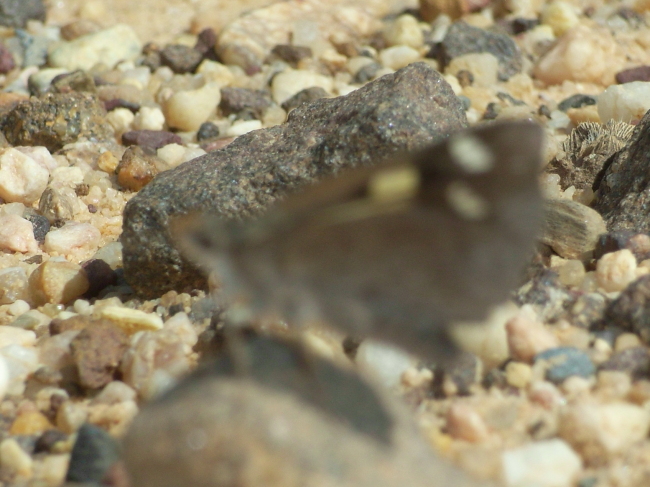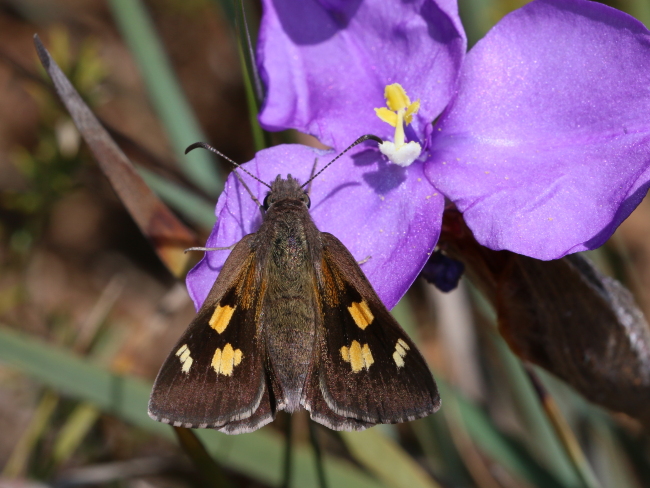The wonderful Montane Iris-skipper (Mesodina aeluropis) is the largest and most colourful of the 5 Mesodina skipper species, all of which are endemic to Australia. It’s a butterfly you need to make some effort to find as it’s only found in a few small subalpine areas of the Great Dividing Range. The map on the Atlas of Living Australia page gives an idea of its distribution, though I really doubt the veracity of that one record from Sydney…
My first photo
Fortunately for butterflyers in the Sydney area (like me!) aeluropis can be found in some of the higher parts of the Blue Mountains. According to Braby it occurs from Wentworth Falls to Clarence, though I personally have not seen it closer to Sydney than Blackheath; in fact that was where I first saw this species. It was Australia Day in 2008, when I went with my pseudonymous friend Max to look for Ant-blues on Hat Hill, but they were they conspicuous by their absence as was just about everything else. The hilltop was practically deserted, except for the two of us.
After a few fruitless hours I went down to the road to look around a couple of other spots. A few hundred metres down the road I saw a large, dark skipper zipping around a few inches above the ground. When it settled on a small pebble I could immediately see the yellowish spots that indicated it was aeluropis, so I attempted to sneak up on it to take some photos. Being about as stealthy as an arthritic hippo I repeatedly failed to avoid disturbing the very alert butterfly, but my persistence paid off and eventually I got within range of my little point-and-shoot camera (this was before I splashed out on a DSLR). I carefully knelt down on the unsealed road and was able to take one photo before the butterfly disappeared, never to be seen again. As you can see, it was a Maxwell Smart moment – “missed it by that much” – though I did focus beautifully on the pebble just behind the aeluropis.

Now I’ll be the first to admit I’ve published some pretty dodgy photos on my website at times, but even I have some standards and this photo wasn’t up to scratch even for me.
Just the odd one or two…
It was to be another 11 months until my next fleeting encounter with this species, which was on another Butterflying trip with Max, this time to the Cathedral Rock National Park in NSW’s New England Tableland. It was a wretched November day, cold and overcast, with absolutely no sign of our target species (Hesperilla hopsoni, which I still have not been able to photograph). Whilst driving back to the Park’s exit Max spotted a large female aeluropis bumbling about near the roadside, so we chased her around for a while and I was able to get a couple of photos. Whilst not fantastic shots they were waaaaaaay better than my previous effort!
Despite seeing one extremely ancient male near the Boyd River campground in the Kanangra-Boyd National Park in January 2010, I didn’t photograph the species again until January 2011. Once again I had gone to Blackheath on Australia Day, and I saw a couple of males disputing who should perch on which pebble on an unsealed section of Hat Hill Road. One of them – a nice specimen too – allowed me to get a photo, and a couple of days later I went back and saw a rather faded female.
Colonies!
Over the years I’ve walked the length of Hat Hill Road many, many times but I’ve only photographed aeluropis there on 3 or 4 occasions, plus I once found one in the process of being eaten by a praying mantis. I assume that the road is close to a breeding colony and that I just get to see the odd specimen because I haven’t found the precise location of the colony itself.
However, I have had the pleasure of seeing an aeluropis colony in full swing at a site close to the Zig Zag Railway’s Clarence station, where a fairly well-known colony exists beneath a line of electricity pylons cutting through the woodland. The Montane Iris-skippers are there because there is an abundance of their larval foodplant Patersonia sericea, a low-growing Iris with lovely purple flowers. I first visited this site when my mate Al Hopkinson took me there in mid-November 2016; it was the perfect time to go as there were dozens of aeluropis on the wing and most of them were very fresh.
The unsealed track beneath the power line was the males’ domain – they scooted back and forth constantly, battling each other over ownership of particularly good pebbles, upon which they would perch to survey their hard-won few square metres of territory. Once properly settled they were generally easy enough to approach unless a rival male appeared, at which my subject would take off at high speed.
The females were almost exclusively to be seen around the Iris plants, frequently landing on them to bask in the sun though I didn’t see any attempting to lay eggs. A fraction larger than the males at 35mm across, the females were a rich chocolate-brown with large yellow spots – almost orange in very fresh specimens. Admittedly it’s pretty much the standard design for a hell of a lot of Skipper species, but a fresh aeluropis glowing in the sunshine is a sight to be savoured!


‘Time after time the clouds rolled in within a few minutes of me getting there’ – I know that feeling so well. Usually happens after a 500km drive to twitch a rare montane species. Some LepSoc Africa members call it ‘Woodhall’s Personal Cloud Cover’!
My late friend Bob used to accuse me of bringing clouds and rain with me every time I went to Cairns to look for butterflies.
Rainclouds love me so much that I’ve considered switching careers and becoming a professional drought-breaker. For a fee I would visit drought-stricken areas and simply by removing the lens cap from my Sigma 150mm macro I could ensure they receive as much rain as they need.
Another great write-up on Mesodina aeluropis, i have to say that this skipper is one of my favourites, probably because it took me so long to finally see one in the wild. After many unsuccessful trips to locations where it was known to be found and drawing a blank, It was Ed Petrie who generously shared one of his honey hole sites for aeluropis that i got to see how beautiful these little skippers are in freshly emerged condition.
That particular site is also great for a number of other skippers, just a couple of weeks after the aeluropis are finished, the Trapezites kick off their but that’s another storey.